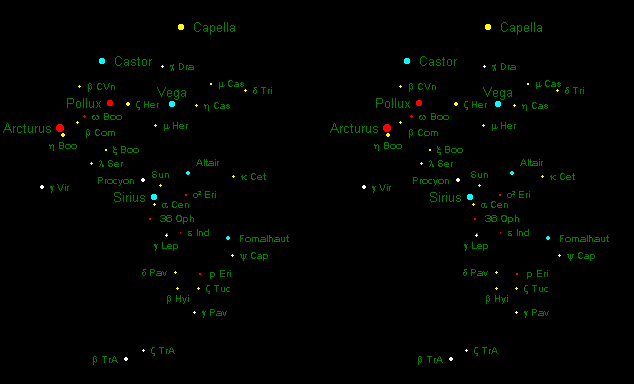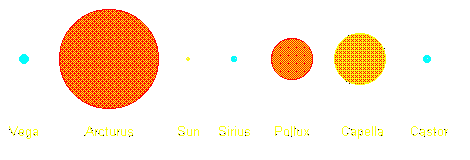
(Or: how much one can get out of drawing circles)
If you came to this page after examining our stellar neighborhood from a 12 l.y. distance, then you might want to take a “step back”, say, at around 50 l.y., and watch it from that distance. Here is what you would see then.

This view shows several familiar stars, such as Arcturus (alpha Bootis), Vega (alpha Lyrae), Capella (alpha Aurigae), and Altair (alpha Aquilae). (All these alphas mean that these stars are the brightest ones in their constellations.) You can see Sun as a yellow spot in the center, and Sirius, a larger bluish spot close to the Sun, at its lower-left side. Alpha Centauri looks deceptively farther than Sirius. If you manage to see this image in 3 dimensions, however, you will notice that Sirius actually stands out in front of the screen, while alpha Centauri is at the same plane with the Sun. (Need instructions for seeing in 3-D? Click here.) Look also at the beautiful pair of gamma Leporis, to the south of Sun (in 3-D, actually to the south-and-front), with its nice white-red contrast.
How about the actual diameters of these stars? Sun looks pretty dwarfed among its neighbors.
In the previous, closer look of our neighborhood, we saw several red and brown dwarf stars (Proxima, Barnard’s, etc.). Are there any in the above figure? Actually not. Even the smaller reddish stars are close to Sun’s diameter (they range from 0.4 to 0.9 Sun diameters). So what happened to dwarf stars? They should be there, but they should also be too tiny to “see” (depict) from this distance. And there should be so many of them that if we devoted even one red pixel for each, the above figure would contain hundreds of such red pixels. (As a measure, you may consider the Sun - alpha Centauri distance — a little more than 4 l.y. — as a quite typical interstellar distance between stars in our neighborhood of the Milky Way galaxy).
So instead of red dwarfs, let’s take a look at the diameters and colors of some stars which are larger than Sun. Here are the most significant ones.

Doesn’t the orange Arcturus look big? You can easily find it in the real night sky if you live in the northern hemisphere: Locate the Big Dipper (Ursa Major), follow the arc of the three stars at the “handle” of the dipper, and extend the arc a bit following its curvature. Arcturus is somewhere there at the extension, brighter than any of the Big Dipper stars, and a bit orange-like in color, if you are good at perceiving the color of stars at night.
Look at Sirius in the middle, which was one of the largest stars in our previous, closer look: now it looks rather insignificant compared to the giants Pollux, Capella, and Arcturus. Pollux and Castor, by the way, are the two “twins”, in the constellation of Gemini. They look approximately equal in brightness from Earth, in spite of their difference in diameters (and their almost equal distances) because Castor is intrinsically much brighter than Pollux: the latter, with a diameter of 9.1 times that of Sun, shines as much as 32 Suns, while the former, having “only“ 1.9 Sun diameters but being a hot bluish star, has a luminosity of 28 Suns, almost as much as Pollux. For comparison, Capella’s luminosity is 72, and Arcturus’s 98.
Vega, at left, is also easily spotted in the northern hemisphere’s night sky, being only the fifth brightest star overall (here we mean “fifth by apparent magnitude”, i.e., as it appears on our eye’s retina from Earth; the first in apparent magnitude is Sirius). Just raise your head during any summer night, virtually any time, and look straight up, at the sky’s zenith: The brightest star you can see somewhere close to that area is Vega. It used to be the Polar Star some 12,000 years ago, long before the Egyptians built their first pyramids, and it will become again the Polar Star some 12,000 years from now, as the Earth’s axis will slowly glide towards it through the millennia.
Take a good look at Sun, depicted here for the last time as something larger than a single pixel, because as we move farther away we will find even larger stars, which we will need to squeeze within our screen limits, making our Sun impossible to depict.
We will see this pattern continuing: why we find larger stars as we move away from Sun? Is this some kind of conspiracy? No, the stars are truly randomly distributed in space — at least in our part of the galaxy. What happens is that as we move farther we increase our chances of hitting upon some really large star. Conceivably, we could be in the position of the star eta Bootis (shown in the 3-D plot above), a mere three light-years from Arcturus. If we were at a planet orbiting eta Bootis, Arcturus would be a very spectacular view at “night” — it would actually turn night to day. But not many stars are in the special location of eta Bootis, and Sun is a rather mediocre star in an average location.
Please note that although the angles for each star (right ascension and declination) are known to great accuracy, the same is not true for their distances. In general, the farther the star, the less accurately we know its distance. For instance, distances of stars in this page might vary by 10% or so.
To construct the above drawings I used data from Richard Dibon-Smith’s StarList 2000 (John Wiley & Sons, New York 1992, ISBN 0-471-55895-8). The 3-D drawings were done by a program of mine, whose interface, unfortunately, is not designed yet with the idea of somebody else — other than me — using it. When I improve that, I’ll make it publicly available.
This kind of “comparative tour” will continue in the future, with more figures from our stellar neighborhood, and beyond.
Back to the zoomed-in view of our solar system.